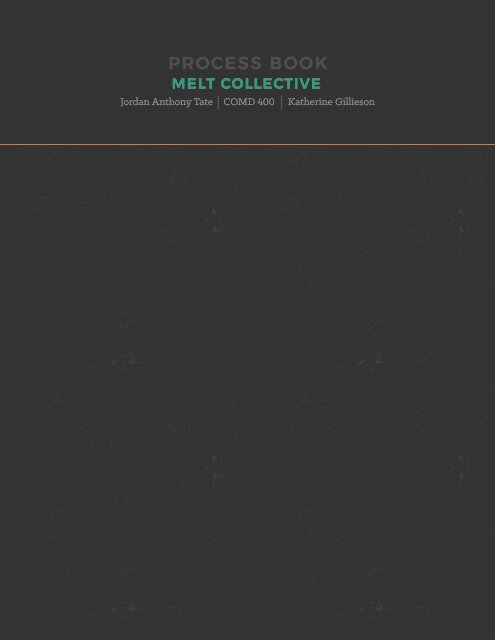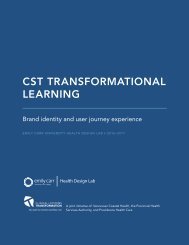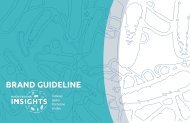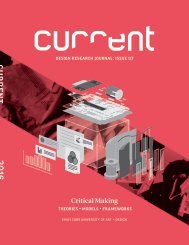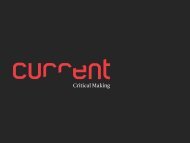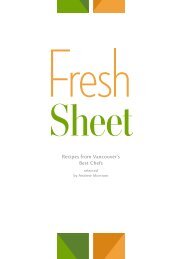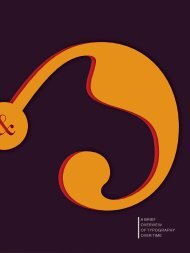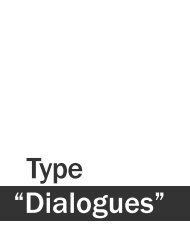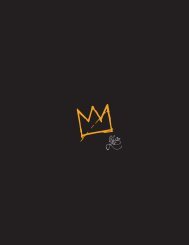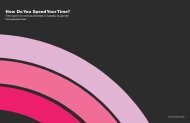Jordan Anthony Process Book
Process book for Melt collective project
Process book for Melt collective project
You also want an ePaper? Increase the reach of your titles
YUMPU automatically turns print PDFs into web optimized ePapers that Google loves.
process book<br />
melt collective<br />
<strong>Jordan</strong> <strong>Anthony</strong> Tate COMD 400 Katherine Gillieson<br />
1
contents<br />
project<br />
introduction<br />
research and<br />
proposals<br />
5 11<br />
2
design phase<br />
appendices<br />
40 62<br />
3
project introduction<br />
problem space<br />
infrastructure /<br />
facilities<br />
behavior / practice<br />
/knowledge<br />
recycling culture<br />
Is the motivation related to the<br />
recycling behavior. Meaning the<br />
attitudes, knowledge, and awareness<br />
of the relative society on the concept<br />
of recycling which depends on the<br />
behavior/ practice/ knowledge.<br />
recycling behavior<br />
Is the actual act and practice of<br />
recycling which depends on the<br />
facilities and infrastructure<br />
of the campus.<br />
I had some difficulty discerning the problem space for this project. Essential the main<br />
goal of this project was to achieve sustainable behavior change in plastic recycling and<br />
sorting practices and an improved change in perspective of discarded plastic from waste<br />
to resource within the UBC community.<br />
At first, I considered UBC campus as the only problem space involved within this project<br />
but as I moved further into research I discovered that the problem also lies internally<br />
within each member of the UBC community.<br />
Further research presented two relative problems spaces to investigate concerning the<br />
UBC campus and its community.<br />
4
zero waste action plan<br />
In the fall of 2010, UBC initiated a process to engage<br />
the Vancouver (Point Grey) campus community<br />
in the development of a Zero Waste Action<br />
Plan. The Plan sets out goals, targets, and actions<br />
that will move the campus toward a vision of UBC<br />
as a zero-waste community. In the context of this<br />
plan, Zero Waste is as much a guiding principle<br />
or philosophy as an aspirational target, where all<br />
unwanted products and materials will be treated<br />
as resources that can be used again, resulting<br />
in virtually zero garbage. UBC has implemented<br />
many successful recycling and composting programs<br />
and policies to date. During the three years,<br />
2011/12/13 period, the operational waste diversion<br />
(away from landfill and incineration disposal) was<br />
approximately 45%, slowly and steadily increasing,<br />
and construction and demolition waste diversion<br />
were fluctuating around 84%. This led to approximately<br />
61% of UBC’s overall waste being diverted<br />
during this period. On the path to zero waste,<br />
UBC’s Vancouver campus is targeting an increase<br />
in its overall diversion rate to 70% by 2016 and<br />
80% by 2020, despite inevitable campus growth.<br />
With decreased disposal comes decreased the<br />
cost for many materials, bringing the potential for<br />
a cost-neutral plan to be implemented over the<br />
longer term.<br />
(UBC Vancouver Campus Zero Waste Action Plan)<br />
5
zero waste action plan<br />
Even though UBC has implemented multiple<br />
sustainability-related initiatives and infrastructure<br />
they have not been able to meet their projected<br />
waste diversion metrics stated in the 2014 Zero<br />
Waste Action Plan.<br />
The UBC Zero Waste Action plan (UBC Vancouver<br />
Campus Zero Waste Action Plan) intended to<br />
- through the use of newly implemented strategies<br />
such as the multi-stream waste bins- increase the<br />
re-usable operational waste diverted from landfills<br />
to 70% by 2016. However according to the Zero<br />
Waste Action Plan – 2016 Status Report (UBC Zero<br />
Waste Action Plan – 2016 Status Report and Update)<br />
waste diversion only showed an insignificant<br />
increase from last years (2015) 63% to (2016) 67%.<br />
The report mentions various factors that might<br />
have affected these results but various studies and<br />
reports from the UBC Social Ecological Economic<br />
Development Studies (SEEDS) department related<br />
to the Zero Action Plan initiative, highlights other<br />
critical issues which might have had a significant<br />
effect on the 2016 diversion metrics.<br />
infrastructure/ facilities<br />
Based on the results of quantitative and qualitative<br />
methods of research done in the GEOG 371<br />
Zero Waste Campus Project student report (Fazel<br />
et al.), there was suggestion of multiple factors<br />
that played an instrumental part in the lackluster<br />
recycling behavior and waste diversion. All the<br />
mentioned suggestions from the report involved<br />
strategic placement of the multi stream waste<br />
bins on the campus within the context these main<br />
influencer which were convenience, proximity to<br />
food outlets, accessibility in high traffic areas and<br />
bin capacity.<br />
Another factor related to the infrastructure / facility<br />
issue was the confusion and misinterpretation<br />
of signage found at the individual waste stations.<br />
This issue usually results in missorting of discarded<br />
waste in the waste stations causing cross-contamination.<br />
Missorting of waste at waste stations is<br />
a prominent issue as missorted waste whether it is<br />
recyclable or not will ultimately end up in a landfill<br />
which is the overarching issue and end state in<br />
which we want to avoid. A report on the Reasons<br />
for Contamination of Outdoor Organic Waste Stations<br />
at the University of British Columbia ( Barnes<br />
et al.) states that “Without even reducing the<br />
amount of waste produced or making infrastructural<br />
changes, UBC could reduce the amount of<br />
garbage sent to the landfill by 45% if UBC students<br />
and staff sorted out their waste correctly”. (Smyth,<br />
Fredeen, and Booth) and (“Waste Audit”) both<br />
highlight the importance of conducting research<br />
on the characterization of waste composition<br />
and its spatial variability in order to enhance the<br />
sustainability of an on-campus waste management<br />
6
system.” Various studies of the effectiveness of<br />
visual cues and signage present at waste stations<br />
found at UBC campus highlights important issues<br />
that should be addressed to improve waste sorting<br />
behavior. Studies done by the SEEDS department<br />
examines the reasons associated with the missorting<br />
of waste. From the information studied<br />
from the reports, there were three major factors<br />
which influenced waste-sorting behavior: clarity<br />
of information, proximity to receptacles and the<br />
emotions they evoke. (Chiykowski et al.)<br />
behavior/ practice/ knowledge<br />
Along with the variables presented in the Infrastructure<br />
and facilities category, there are other<br />
factors related to the recycling culture which<br />
influences diversion metrics. According to a<br />
study on increasing recycling at Leeds University<br />
(Clay), there are 4 relevant variables that influence<br />
recycling culture: knowledge of recycling scheme<br />
and awareness of recycling, social pressure and<br />
the creation of social norms, belief in the benefits<br />
of recycling, general environmental concern and<br />
conservation behaviour.<br />
The following extract from the GEOG 371 Zero<br />
Waste Campus Project student report (Fazel et al.)<br />
effectively summarizes the importance of recycling<br />
culture in improvring recycling behavior and<br />
ultimately diversion rates.<br />
Multiple scholarly articles have emphasized the<br />
importance of educating recycling bin users in<br />
creating a sustainable community (Olson, Arvai,<br />
and Thorp) , surveyed a sample of undergraduate,<br />
graduate students, as well as the faculty members<br />
of Michigan State University (MSU). They created<br />
a general mental model representing the subjects’<br />
understanding of the MSU concept of recycling<br />
(Olson, Arvai, and Thorp) Their results demonstrated<br />
that consumer participation is the most<br />
significant factor in recycling rate, and educating<br />
the consumer promotes consumer participation.<br />
(Pike et al.) also argued that for a green sustainable<br />
campus, students must be educated on where<br />
recycling stations are and what can be recycled.<br />
The researchers focused on the university student<br />
residence at Francis Marion University in<br />
South Carolina and concluded that students who<br />
received both the recycle bins and the recycling<br />
education had the highest rate of recycling. This<br />
study carefully considered the correlation between<br />
recycling behaviors and implementation of<br />
recycling culture through education.<br />
Installing recycle bins without implementing the<br />
culture of recycling does not promise a sustainable<br />
campus. It is through combining education<br />
and real life practices that we can achieve the<br />
UBC’s goal of waste reduction.<br />
7
These extracts from Sean Clay’s study on increasing<br />
recycling at Leeds University (Clay) also adds supplementary<br />
confirmation to the previous summary.<br />
It is clear that recycling behaviour is determined by<br />
complex interactions between a variety of factors, and<br />
that increasing recycling participation will require<br />
careful management of these factors. This study has<br />
demonstrated high levels of environmental concern<br />
and a strong support for recycling among the students<br />
of the University, although this is not always translated<br />
into effective action. However, there are various<br />
means by which this attitude-behaviour inconsistency<br />
can be changed.<br />
Improving the recycling knowledge and awareness<br />
of the students has been shown to be vital to improving<br />
recycling rates. Fortunately, this is relatively<br />
easy to achieve, through the use of simple information<br />
provision and prompting techniques. This should<br />
include information about the relevance and effectiveness<br />
of recycling in alleviating waste management<br />
and consumption problems, specific details of the<br />
recycling facilities available in the University and the<br />
importance of recycling to the community and wider<br />
national interests. In a University setting, such information<br />
can be easily communicated to a large section<br />
of the student population by posters, flyers or email.<br />
The promotion of recycling as a social norm should<br />
be encouraged as social influence can greatly affect<br />
recycling. Those students already recycling should<br />
attempt to engage their peers in this activity, or in a<br />
more structured use of social influence special recycling<br />
volunteers could be selected to actively promote<br />
recycling among their peers. The use of behavioural<br />
experience can also be employed, as students are<br />
more likely to start recycling items they are already<br />
familiar with. Recycling forums could be set up to<br />
determine such information, and to elicit recommendations<br />
from the wider student body on how recycling<br />
could be made more accessible in the University. Fostering<br />
good environmental concern and promoting<br />
other conservation behaviours among students will<br />
also serve to benefit recycling.<br />
The single variables found to be of the most significance<br />
in this study were knowledge of recycling<br />
followed by perceived social influence. Personal<br />
satisfaction derived from recycling and ecological<br />
concern were also significant, along with the<br />
frequency of collection, although this factor is not<br />
relevant in terms of University recycling. The study<br />
concludes that the best and most practical method of<br />
inducing good recycling behaviour in the long term is<br />
to concentrate on increasing internal incentives and<br />
facilitators, specifically knowledge of recycling and<br />
its benefits, and reduce external barriers to recycling.<br />
Taking the outlined factors of recycling behaviour<br />
and recycling culture into consideration the UBC<br />
waste diversion metrics can be significantly improved.<br />
8
However Influencing behaviour change is a complex task, especially recycling behaviour.<br />
Considering the constraints and scope of my project I decided to focus only<br />
on plastic recycling. Moreover;<br />
How can design inform/ influence the best methods or strategies to change or improve<br />
the narrative of discarded plastic from waste material to valuable resource<br />
- and also the best ways to inform and provide information and awareness to the<br />
UBC community of plastic recycling?<br />
9
esearch and proposals<br />
here enters<br />
Melt Collective is a creative sustainability<br />
hub which gives students the opportunity<br />
to bring their product ideas to life from<br />
free waste materials. At the same time<br />
helping to close the loop and to localise<br />
recycling, we reduce the carbon and economic<br />
cost of recycling this material.<br />
Melt Collective is an Information, awareness,<br />
knowledge/ learning hub which will<br />
provide the UBC community with handson<br />
learning on various plastic recycling<br />
related topics such as; best practices and<br />
issues of improper recycling. Students<br />
will also learn immersively about how<br />
different materials can be reused, and<br />
the different properties that make the<br />
materials useful.<br />
10
project proposal<br />
Melt Collective is a student-led recycling workshop and<br />
laboratory based out of UBC campus. Our primary goal<br />
is to prove that UBC’s waste plastics can be upcycled<br />
and sold on campus, by developing a community that<br />
promotes transparency in recycling and spreads education<br />
about closed-loop economies and extended product<br />
life-cycle awareness.It is also a project for student involvement,<br />
skill development and ongoing research, built<br />
on the sustainable principles of reusing waste and saving<br />
marine ecosystems--the primary victims of plastic waste.<br />
By creating useful products and resources from this waste,<br />
we can foster an economic incentive for ocean clean-up.<br />
My project aims to through research, find and implement<br />
the most suitable and viable communications/education/engagement/design<br />
strategy into the form of a<br />
sustainability campaign. Then, through collaborating with<br />
the”Melt Collective”;<br />
• Provide information and awareness to the UBC community<br />
on various plastic recycling related topics such<br />
as; best practices and issues of improper recycling<br />
• Promote the Melt Collective and its services within the<br />
UBC community.<br />
• And chiefly to make an attempt to change the narrative<br />
of discarded plastic from waste to valuable resource.<br />
11
pillars<br />
oceans<br />
education<br />
Our oceans are littered with plastic waste. We<br />
see photos of sea birds, stomachs askew with a<br />
lifetime of ingested plastic. Surfing in Morocco,<br />
the beaches were littered with plastic waste. The<br />
first of these factories will be in Vancouver, then<br />
soon around the world. Waste will be transformed<br />
into useful goods, creating an economic<br />
imperative for the material. In turn the profits<br />
can be used to help clean our beloved oceans.<br />
For starters, regular Beach Cleanups (in partnership<br />
with Surfrider and Northwest Wildlife<br />
Preservation Society) with a twist: after cleanup,<br />
involve the volunteers in the recreation process,<br />
making new things directly from the waste<br />
Outreach to local environmental groups and<br />
especially elementary and high schools will begin<br />
in 2017, once our AMS club has established operations<br />
and is collecting, sorting and producing.<br />
The school and group tours will involve collecting<br />
plastic waste, touring the recycling workshop,<br />
live demonstrations of the machines and discussions<br />
about research and the future of recycling,<br />
including globally in developing nations as well<br />
as the large-scale ocean cleanup that must occur.<br />
Overall, the goal of these tours will be to present<br />
a transparent walkthrough of how recycling can<br />
work.<br />
12
esearch<br />
community awareness<br />
In developing nations like India and Ghana,<br />
overrun by e-waste and plastic trash, people<br />
struggle to recycle it into new things. Without the<br />
tools and information to properly recycle, they<br />
often resort to burning the plastic for energy,<br />
or using the ‘burn-and-sniff’ sorting method,<br />
to guess at what material a plastic might be. As<br />
UBC is a leading research institution, the Plastic<br />
Workshop will support student research into<br />
novel sorting and processing methods, with the<br />
goal of creating affordable sorting technology<br />
that can be spread around the world to help<br />
improve the health of amateur recyclers. By preventing<br />
exposure to the dangerous fumes burning<br />
plastic expels, health risks can be mitigated.<br />
Plastic doesn’t come from the store and go to<br />
the recycling bin, but it sure seems so. We aim<br />
to reshape this narrative; creating long-lasting<br />
plastic products. More deeply, though, by developing<br />
a craft from recycling plastic, people will<br />
create objects that they value--like that ceramic<br />
mug or wooden chair you treasure, a plastic<br />
plant pot you create could be a beautiful, long<br />
term possession. Fostering a deeper connection<br />
with the objects we use, plastic can cease to<br />
be viewed as a disposable, and be appreciated<br />
for its unique properties and cherished, when<br />
shaped by hands, with love. While we create<br />
these products, we hope to foster a community<br />
of like-minded ‘melters’, intent on sharing<br />
knowledge about the new craft.<br />
13
process flow diagram<br />
Gathering metrics about<br />
waste streams and<br />
separating different types<br />
of plastics into groups.<br />
Removing of contaminants<br />
and debris which helps reduce<br />
machine clogging.<br />
Plastic is broken down into small<br />
pellets to allow for easy and<br />
accurate manipulation of the<br />
plastics.<br />
Compression mold is used for<br />
molding more creative items.<br />
Injection mold is used for<br />
industrial molded parts or items.<br />
Extrusion machine creates<br />
spaghetti like material which is<br />
used as material for 3D printers.<br />
14
materials<br />
Fig 1<br />
Diagram illustrating the<br />
process and products of the<br />
Melt Collective<br />
Discarded plastic is retrieved and<br />
sorted from the recycling bins.<br />
Stickers are removed and plastic is<br />
cleaned so no contaminants and<br />
debris will aect later processes.<br />
Plastic is broken down into small<br />
pellets to allow for easy and<br />
accurate manipulation of the<br />
plastics.<br />
Extrusion filament<br />
used for 3D printers<br />
Industrial parts. Injection molding<br />
is the most common modern<br />
method of manufacturing plastic<br />
parts; it is ideal for producing high<br />
volumes of the same object. (Surf<br />
Fins, Penny boards etc).<br />
Compression molding can<br />
be used for creative one<br />
time items. (Plant Pots.)<br />
15
ubc sustainability and sort-it-out campaign analysis<br />
An analysis of the current sustainability clubs;<br />
“Sort-It-Out” identity/ informational/ educational<br />
material was done to assess the efficiency and<br />
effectiveness. Points and information from other<br />
assessment of similar cases were taken into consideration<br />
and used in my assessment to ensure<br />
an unbiased conclusion.<br />
The Sort-it-Out campaign is a child initiative of<br />
the UBC sustainability brand. The implementation<br />
of the Sort-it-Out campaign resulted in the campus-wide<br />
rollout of multi-waste stream stations<br />
which allowed the UBC community to effectively<br />
recycle their waste in most areas on campus.<br />
Along with the improved facilities and infrastructure,<br />
there were multiple campaign materials such<br />
as posters, banners, social media implementation,<br />
events etc.<br />
Even though these additional materials have<br />
proven to be beneficial to improving waste sorting<br />
behaviour (Cohen, Hockley, and Tims), it has yet<br />
to prove as effective as the projections from the<br />
zero waste action plan anticipated. In fact current<br />
unpublished research conducted in the form of<br />
a waste audit organised by UBC’s largest student-run<br />
sustainability club on campus, Common<br />
Energy, determined that in March 2014, 73% of the<br />
waste in the garbage streams in the Old SUB was<br />
incorrectly sorted and could have been redirected<br />
into the other three streams. In March 2016, a<br />
waste audit was conducted of the Nest that determined<br />
80% of the waste in the garbage stream was<br />
incorrectly sorted, suggesting that waste-sorting<br />
behaviours of users worsened from the Old SUB<br />
to the Nest. (Foster)<br />
According to the UBC Sustainability Communications<br />
Guidelines<br />
The UBC sustainability visual strategy was designed<br />
to:<br />
• Share the UBC sustainability story in ways that<br />
engage and inspire target audiences.<br />
• Reflect “Tier One” quality through messaging<br />
and creative.<br />
• Align with the UBC Brand.<br />
• Scale across diverse print and digital media<br />
channels<br />
(“Sustainability Communications Guidelines”)<br />
The UBC sustainability brand has also defined a<br />
set of “sustainability criteria” to support their collective<br />
efforts and ensure campus-wide cohesion.<br />
The Waste criteria are;<br />
• Contributes to campus zero waste (recycling,<br />
reduction, reuse)<br />
• Contributes to closed loop waste management<br />
(“Sustainability Communications Guidelines”)<br />
16
There are 5 key considerations that need to be applied<br />
when utilising the UBC sustainability brand<br />
USE THE OFFICIAL RIPPLE VISUAL ELEMENT<br />
For institutional communications relating to climate and<br />
energy, recycling and waste, food and purchasing, transportation<br />
and social well-being,<br />
PROMPT SUSTAINABILITY BEHAVIOURS<br />
The Ripple is a visual reminder to behave more sustainably.<br />
Be strategic about where you use the Ripple and ensure it<br />
has good visibility and can be easily understood by a broad<br />
audience.<br />
USE EMILY CHARACTER IN STUDENT FOCUSED<br />
COMMUNICATIONS<br />
For student communications on sustainability, the character<br />
and messaging of ‘Emily’ is used to engage and educate<br />
students on various sustainability initiatives at UBC.<br />
UBC sustainability communications<br />
should employ aspirational language that<br />
creates a desire in our audience to become<br />
change-agents, community leaders,<br />
and responsible global citizens. By using<br />
cohesive, enterprise-wide visual elements,<br />
sustainability at UBC becomes a societal<br />
conversation about the world we want<br />
to live in and an active realization of our<br />
commitment to being a living laboratory.<br />
(“Sustainability Communications Guidelines”)<br />
USE THE OFFICIAL SUSTAINABILITY URL<br />
AND HASHTAG<br />
On all digital sustainability communications, please use<br />
the official UBC sustainability website URL, sustain.ubc.ca,<br />
and utilise the Ripple Effect hashtag, #RippleEffectUBC, to<br />
engage audiences at UBC and beyond on important sustainability<br />
issues, events, campaigns and research.<br />
BE POSITIVE<br />
The language and tone for sustainability communications at<br />
UBC should be positive and encourage versus negative and<br />
punitive.<br />
17
ubc sustainability and sort-it-out campaign analysis<br />
Fig 2<br />
Ripple effect visual device<br />
The ripple effect is a core visual device for UBC sustainability,<br />
intended to help communicate our story in<br />
a simple, creative and inspiring way.<br />
The term ripple effect was coined by educational<br />
theorist Jacob Kounin: “One small change can create<br />
a ripple effect that leads to greater changes with profound<br />
impact.”<br />
In our sustainability efforts at UBC, one small change<br />
can create a ripple that leads to greater changes on<br />
campus, in our local community and, ultimately,<br />
around the world. It speaks to a convergence of ideas<br />
and conceptual integration.<br />
Food Scraps:<br />
Cooked food waste<br />
Raw fruit, vegetables & grains<br />
Bones & egg shells<br />
Dairy products<br />
Paper towels & napkins<br />
Compostable* paper plates<br />
Compostable* food containers<br />
Non-synthetics tea bags<br />
Plain, uncoated wood chopsticks<br />
Keep Out:<br />
Plastic bags & plastic containers**<br />
Biodegradable plastic bags<br />
All plastic cutlery &<br />
plastic chopsticks<br />
Diapers<br />
Dog waste<br />
** Food containers must be certified compostable, fibre based.<br />
** Certified compostable plastic products are not acceptable<br />
in the Food Scraps bin.<br />
Recyclable Containers<br />
(clean/empty only):<br />
Plastic #1-7 containers<br />
Glass bottles & jars<br />
Metal cans<br />
Milk cartons<br />
Recyclable plastic bottles<br />
Recyclable cups & cutlery<br />
Juice boxes<br />
Tetrapak containers<br />
Non-paint aerosol cans<br />
(empty, no toxic residues)<br />
Keep Out:<br />
Food & Liquids<br />
Plastic bags & styrofoam<br />
Dishes, glassware or ceramics<br />
Windows or mirrors<br />
Unstamped plastics<br />
Paper (clean only):<br />
Newspapers & magazines<br />
Envelopes<br />
Computer paper<br />
Paper cup sleeves<br />
Cereal boxes<br />
Telephone books<br />
Sticky notes<br />
Soft cover books<br />
Keep Out:<br />
Milk cartons<br />
Paper cups<br />
Used paper plates<br />
Pizza boxes<br />
Soiled paper<br />
Garbage:<br />
Plastic bags<br />
Styrofoam<br />
Plastic wrap<br />
Candy bar wrappers<br />
Chip bags<br />
Non-recyclable cutlery<br />
Waxed paper<br />
Aluminum foil<br />
Keep Out:<br />
Anything compostable<br />
or recyclable<br />
The visual concept of the ripple creates a fluid expression<br />
across diverse media in graphic, photographic<br />
and video form, immediate Sort it out ly identifying<br />
the content as sustainability-related.<br />
The graphic representation of the ripple effect depicts<br />
the intersection of three sustainability perspectives:<br />
economic, environmental and social. The ripples carry<br />
static animation, with the larger set of rings being the<br />
first drop and the smallest being the most recent.<br />
Fig 3<br />
Use of Emily mascot in campaign<br />
material<br />
18
DID YOU KNOW<br />
Most of UBC’s<br />
garbage can<br />
be recycled?<br />
TOWARDS ZERO WASTE<br />
Composting and<br />
recycling at UBC:<br />
Right now, we’re<br />
only recycling<br />
LESS THAN 50%<br />
Our goal is to reach<br />
60% BY 2016 &<br />
80% BY 2020<br />
GARBAGE WE SENT<br />
TO LANDFILL IN 2013:<br />
3000<br />
TONNES<br />
OR 19 BLUE<br />
WHALES<br />
NUMBER OF YEARS<br />
TO DECOMPOSE IN<br />
THE LANDFILL:<br />
PAPER<br />
5 20 200 500 1,000,000 NEVER<br />
FOAM<br />
AMOUNT OF RECYCLABLE MATERIAL IN UBC’S GARBAGE:<br />
FOOD SCRAPS<br />
AND COMPOST 48%<br />
PAPER<br />
PLASTICS<br />
METAL AND<br />
GLASS<br />
17.5%<br />
11%<br />
7.5%<br />
Garbage in landfills creates a higher risk of<br />
soil, water and air pollution. It also creates<br />
the greenhouse gas methane, which is 20<br />
times worse than CO .<br />
UBC is aspiring to be a “Zero Waste” campus where all<br />
unwanted products and materials will be treated as resources<br />
that can be used again. To reduce environmental impacts,<br />
greenhouse gas emissions and garbage disposal costs we can<br />
all do our part. Please take an extra second and Sort it Out.<br />
and create a green, zero waste campus:<br />
USE RECYCLING STATIONS TO SORT YOUR FOOD SCRAPS AND RECYCLABLES INTO THE PROPER BINS.<br />
FOOD SCRAPS RECYCLABLE<br />
CONTAINERS<br />
Fig 4 Sort-It-Out Infographic<br />
PAPER GARBAGE<br />
To reduce our environmental<br />
footprint and reuse our resources,<br />
UBC is replacing garbage cans<br />
with multi-bin recycling stations.<br />
sustain.ubc.ca/sortitout<br />
Keep plastics out of<br />
green bins.<br />
Plastics of any kind<br />
including regular and<br />
compostable plastic<br />
bags and plastic food<br />
containers, must not be<br />
put in food scraps bins.<br />
sustain.ubc.ca/sortitout<br />
Did you know most of UBC’s garbage can be recycled? You can recycle everyday waste<br />
materials—like food scraps, paper and food or drink containers—at recycling stations. Please<br />
refer to the Sorting Guide at the end of this document for specific information on what goes<br />
into which bin. You can also find more information on the Sort it Out webpage.<br />
recycling stations.<br />
Frequently Asked Questions<br />
Q: What can be recycled and composted?<br />
mixed paper. Refer to the Sorting Guide at the end of this FAQ for more information.<br />
Q: What can’t be recycled?<br />
A: Materials that are not recyclable must go into the garbage. These include: Styrofoam,<br />
plastic bags, potato chip bags and unmarked plastic containers. Materials such as batteries<br />
and electronics can be recycled elsewhere, but not at recycling stations. A good resource<br />
for recycling options is the comprehensive Sorting Guide.<br />
Q: Where are the recycling facilities at UBC?<br />
A: There are over 700 recycling stations located in buildings across campus. Recycling carts<br />
are generally located in student housing recycling rooms, with recycling stations found in<br />
dining halls and food service outlets across campus.<br />
Q: How much garbage does UBC divert from the landfill?<br />
A: As of 2014, we were able to divert about half of all operational waste (not including<br />
construction waste) away from the landfill. However, with proper separation (putting the right<br />
materials in the right bins), most of your garbage can be diverted from the landfill using<br />
UBC’s recycling stations.<br />
Fig 5<br />
Sort-It-Out FAQ<br />
19
ubc sustainability and sort-it-out campaign analysis<br />
Food Scraps:<br />
Cooked food waste<br />
Raw fruit, vegetables & grains<br />
Bones & egg shells<br />
Dairy products<br />
Paper towels & napkins<br />
Compostable* paper plates<br />
Compostable* food containers<br />
Non-synthetics tea bags<br />
Plain, uncoated wood chopsticks<br />
Keep Out:<br />
Plastic bags & plastic containers**<br />
Biodegradable plastic bags<br />
All plastic cutlery &<br />
plastic chopsticks<br />
Diapers<br />
Dog waste<br />
Recyclable Containers<br />
(clean/empty only):<br />
Plastic #1-7 containers<br />
Glass bottles & jars<br />
Metal cans<br />
Milk cartons<br />
Recyclable plastic bottles<br />
Recyclable cups & cutlery<br />
Juice boxes<br />
Tetrapak containers<br />
Non-paint aerosol cans<br />
(empty, no toxic residues)<br />
Keep Out:<br />
Food & Liquids<br />
Plastic bags & styrofoam<br />
Dishes, glassware or ceramics<br />
Windows or mirrors<br />
Unstamped plastics<br />
Paper (clean only):<br />
Newspapers & magazines<br />
Envelopes<br />
Computer paper<br />
Paper cup sleeves<br />
Cereal boxes<br />
Telephone books<br />
Sticky notes<br />
Soft cover books<br />
Keep Out:<br />
Milk cartons<br />
Paper cups<br />
Used paper plates<br />
Pizza boxes<br />
Soiled paper<br />
Garbage:<br />
Plastic bags<br />
Styrofoam<br />
Plastic wrap<br />
Candy bar wrappers<br />
Chip bags<br />
Non-recyclable cutlery<br />
Waxed paper<br />
Aluminum foil<br />
Keep Out:<br />
Anything compostable<br />
or recyclable<br />
** Food containers must be certified compostable, fibre based.<br />
** Certified compostable plastic products are not acceptable<br />
in the Food Scraps bin.<br />
Fig 6 Sort-It-Out Sorting Guide<br />
20
issues with identity<br />
The Sort it out guide (fig 6) is not designed effectively.<br />
when taking into consideration the context<br />
in which this guide would be read- which is at the<br />
moment of recycling, This guide does not allow for<br />
quick and easy comprehension. when in the act of<br />
recycling time and convenience is an important<br />
factor as stated earlier. this guide does not compensate<br />
for this.<br />
The sort it out infographic (fig 4) is a good way of<br />
educating users on the importance and purpose<br />
of the campaign but the design of this campaign is<br />
not inviting to readers. It is too heavily saturated<br />
with colour which overbears on the legibility of<br />
the document.<br />
The use of Emily mascot (fig 3) is a creative platform<br />
to connect with the student body but studies<br />
into the effectiveness of the use of the Emily<br />
character states that it has had an adverse effect.<br />
(Ho et al.) study on the awareness of 3 sustainability<br />
campaign including Sort-It-Out, Ripple Effect<br />
and Emily stated that most students assessed,<br />
was unfamiliar with the Ripple effect and Emily<br />
campaign. The study also stated that participants<br />
thought that these campaigns belonged to other<br />
AMS campaigns not belonging to the sustainabilty<br />
department. It was also stated in the study that the<br />
Emily Campaign was also regarded as “creepy”<br />
The Sort-It-Out FAQ (fig 5) sheet is an essential<br />
element for the sustainability campaign as it<br />
provides pertinent and summarises information to<br />
concerns and questions users will have. however,<br />
it could be improved by introducing more hierarchy<br />
of information, meaning questions or concerns<br />
which have been expressed more frequently<br />
can have a higher visual hierarchy.<br />
21
esearch<br />
In order to properly create an effective campaign to influence the behaviour of the<br />
user involved, I researched into behaviour change theories<br />
The theory of reasoned action was used to map out and fully<br />
understand the problem.<br />
The theory of reasoned action explains behaviour as a result of the person’s intention<br />
to perform that behaviour. That intention is influenced by (i) the person’s<br />
own attitude towards the behaviour, or (ii) the belief that people important to the<br />
person think she/ he should or should not perform the behaviour. Of course, the<br />
person’s own ideas are influenced by the society she or he lives in.<br />
(Ajzen and Fishbein)<br />
motivation ability trigger<br />
If a person believes that the most favourable<br />
outcome will result from a<br />
behaviour, then the person is said to<br />
have a favourable attitude towards<br />
the behaviour<br />
If anticipated outcomes are believed<br />
to be negative then the person will<br />
have a negative attitude towards<br />
that behaviour.(Ajzen)<br />
If the student has a positive attitude<br />
towards the outcome then<br />
they will perform the behaviour.<br />
With the implmentation of the Zero<br />
Waste Action Plan UBC has adopted<br />
a positive sustainabilty culture.<br />
Does the person have the skill set<br />
and knowledge to perform the behaviour?<br />
Does the behaviour require a new<br />
skill set and knowledge?<br />
How can you educate the user?<br />
Most students of the UBC community<br />
posses the required skills to<br />
recycle,<br />
but the knowledge of proper waste<br />
sorting is absent.<br />
Object or interface the user<br />
interacts with<br />
If a trigger is not clear in its purpose<br />
or instruction a friction point<br />
will be the result.<br />
friction point<br />
waste sorting guides are hard to<br />
read and understand.<br />
22
addressing motivation<br />
Eventhough there is a prominent recycling culture<br />
within the UBC community, there is a clear<br />
disparity with the collective mind set of the UBC<br />
community and the resulting behavior.<br />
A UBC sutdent run newspaper (Ubyssey) adequately<br />
summarises this disparity<br />
UBC pats itself on the back for being super<br />
eco-friendly, and one cannot ignore the numerous<br />
campaigns that AMS sustainability and UBC<br />
throw each year. Ripple Effect, Sort-It-Out and<br />
Doing It Green are some of the initiatives that<br />
have become part of our everyday lives. It would<br />
be hard to find someone to argue that UBC is not<br />
respectful of the environment, as ecology is maybe<br />
the one theme that unites students in a pseudo<br />
campus spirit.<br />
Yet, there is still a culture of non-recycling on<br />
campus. “I think most people are like me in the<br />
sense that they won’t walk the extra mile to just<br />
find a bin, even if it is overflowing,” said Brauner.<br />
“They just think that someone will take care of it.”<br />
If students were bored enough to play the thrilling<br />
game of ‘watching how people act when they<br />
approach a recycling station’, they would discover<br />
that a not-negligible fraction of them stop in awe,<br />
before dumping whatever they have in the garbage<br />
bin. Even if it is plastered with the phrase: “Stop!<br />
Is that really garbage?”<br />
David Stonham, who is the Sustainability Projects<br />
Coordinator at AMS sustainability, tried to explain<br />
this particular concern. “If you contaminate one<br />
of the bins, then … there is a big chance that the<br />
whole bin will be rejected and turned into the garbage<br />
stream,” said Stonham before inviting unsure<br />
students to prefer the garbage bin to an<br />
unsafe choice.<br />
But fear of contamination is most likely not the<br />
only factor to account for the persistence of the<br />
non-recycler community. “Maybe they feel like<br />
they do not have a lot of time and they cannot be<br />
bothered to sort through their things,” said Alyson<br />
Small, a first-year Arts student. It is no breaking<br />
news that students are lazy. It is however interesting<br />
to see how laziness, a trait about which many<br />
boast, is suddenly concealed when it comes to recycling.<br />
When we approach a recycling station and<br />
take the daring decision to dump everything in the<br />
garbage, we tend to do it with a muttered slur, and<br />
usually with unnaturally quick movements.<br />
Is that a product of the “green norm” that is commonly<br />
accepted on campus? “If it is the social<br />
norm to recycle, people are going to conform to<br />
that,” said Stonham. “We are trying to make it a<br />
norm.” An enforcement that Freedom Fighters will<br />
not dare criticize. If there are still students who<br />
really do not care about the environment, they are<br />
not very loud, proof that UBC and AMS sustainability<br />
are succeeding in establishing those social<br />
attitudes. “The Sort-It-Out campaign is doing a<br />
pretty good job so far,” stated Stonham.<br />
Yet, as Brauner said, “you can try to educate people,<br />
but that is not always effective.” Be it a product<br />
of this lack of interest or not, the garbage bins<br />
are overflowing at least once a day in the SUB.<br />
(UBC Vancouver Campus Zero Waste Action Plan)<br />
23
primary research; survey<br />
24
25
primary research; survey<br />
26
This participants of this survey included a range of members from<br />
the Melt Collective team. They were chosen because they of all<br />
people considered would know what values and characteristics<br />
best represented the Melt Collective<br />
27
3m communication strategy<br />
appeal to positive emotional state<br />
Positive messaging is seen as more credible and<br />
results in more creative open minded behaviour.<br />
(Fredrickson)<br />
Various studies state that putting readers in a good<br />
mood, through appropriate positive language and<br />
colourful visuals can encourage recall. Designs<br />
should utilise a simple but vivid colour pallet,<br />
and encouraging tone. Use of reprimanding tones<br />
can result in reactance, or intentional defiance<br />
of prompt but good moods have been shown to<br />
encourage recalling of behaviour at future opportunities.<br />
(Sussman and Gifford)<br />
Appealing to negative emotions can lead to scepticism,<br />
feelings of helplessness, and decreased<br />
intention to act (Carter) (Feinberg and Willer).<br />
Negative emotions have also been shown to limit<br />
individuals to think only short term and be less<br />
able to plan for the future. (Carter)<br />
implementation of sort it out visual<br />
elements and identity<br />
The sort it out campaign is one of the most easily<br />
recognisable, understood and accepted sustainability<br />
campaigns within the UBC community.<br />
(Ho et al.) Using aspects of the campaign identity<br />
will allow users to quickly understand the context<br />
and purpose of the campaign. Implementing the<br />
sort it out campaign will also add credibility to the<br />
3m campaign.<br />
implement connection to societal<br />
norms and values<br />
confirmation to society / describing/ promoting<br />
the practive or behaviour as common. “Be like<br />
everyone else” or socially acceptable behaviour.<br />
Robert B. Cialdini’s research on influence states;<br />
“One of the best-studied nudges is the concept of<br />
social norms that can activate particular human<br />
tendencies and trigger automatic behavioural<br />
responses (Cialdini). The fact that people are more<br />
likely to (automatically) accept and follow rules<br />
that are desirable and approved by their group (or<br />
society) makes the “choice architects” empowered<br />
to draw on social norms as a persuasive “weapon<br />
of influence.”<br />
(Byrne and O’Regan) emphasize the importance<br />
of creating positive social norms, because it will<br />
promote positive indi<br />
28
vidual values, attitudes, beliefs and sense of responsibility<br />
towards waste reduction.<br />
relaying “ease” of behavior.<br />
Communicating a notion that recycling is easy<br />
and not hard will result in the user’s likelihood of<br />
accepting the behaviour. “Th eory of Planned Behaviour<br />
(TPB) postulates three independent factors<br />
to determine a behaviour: attitudes towards<br />
the behaviour (refers to the degree to which a person<br />
has favourable or unfavourable attitudes towards<br />
the behaviour); subjective norm (perceived<br />
social pressure to perform or not to perform the<br />
behaviour) and perceived behavioural control<br />
(the perceived ease or the difficulty of performing<br />
the behaviour). Perceived behavioural control can<br />
also be understood as the convenience. If people<br />
perceive recycling to be convenient and easy,<br />
they are more likely to engage in this behaviour.”<br />
(Ummat)<br />
29
3m education strategy<br />
In order to effectively educate and relay knowledge<br />
to the UBC community, the “3M”campaign must<br />
implement an education strategy.<br />
Transparency- if the UBC community knew where<br />
their discarded waste ended up they would be more<br />
mindful of their sorting and recycling behaviour.<br />
Categorical confusion was noticed to be a frequent<br />
issue - use of anti-contamination stickers<br />
Cutlery was highly incorrectly sorted because users<br />
group their waste into a bag or container then dispose<br />
of it altogether<br />
Education should target HOW to recycle as a priority<br />
and why less<br />
Education should address the misconception of<br />
difficulty and inconvenience.<br />
Misinterpretation of difficulty of a service usually<br />
occurs at the initialization phase. Melt Collective<br />
should employ a demo event to not only promote<br />
the campaign but to relay the ease of use. experiencing<br />
the service can change attitudes towards<br />
behaviour.<br />
topics to include<br />
• Where are recycle stations<br />
• Proper recycling behaviour spread awareness of<br />
highly sorted items so special attention is given to<br />
that. benefits of recycling<br />
• Information on the distinction of hard and soft<br />
plastic.<br />
The issue of users not having time to pay attention<br />
to learning materials according to studies are<br />
frequent. In order to address the 3M campaign will<br />
position learning material of the melt collective and<br />
plastic recycling behaviour in areas where users are<br />
more likely to<br />
pay attention<br />
• Table toppers<br />
• At the point of sale<br />
• At the multi-stream recycling stations<br />
( when users utilise the multi-stream waste stations<br />
most users are in a hurry and not much<br />
attention is given to any prompts, therefore,<br />
prompts would have to be attention-grabbing<br />
and easy to follow.)<br />
30
• Floor vinyl which guides the user to the proper<br />
waste stream before they reach. Floor graphics are<br />
a great way of catching attention, as people are<br />
always instinctively scanning the ground as they<br />
walk (Yellow Dog Blog). Floor graphics are most<br />
effective when they are linking orguiding the user<br />
to an item that is at eye level, and in this case,<br />
the floor graphics will lead to the recycling bins<br />
(Jessup) . They are effectively used in retail advertising,<br />
as they catch the eye of consumers and<br />
influence their decision making. (Theses, School,<br />
and Zandecki)<br />
• Ka-ching- sound prompt when depositing plastic<br />
waste. ( Reward of recycling)<br />
• The 3M campaign could also implement a sorting<br />
guide specific to the geographical location on<br />
campus, respective to the restaurants or stores<br />
found in that general area.<br />
(For example, in the village, there is a bubble tea<br />
store, a McDonald’s and the basement consisting<br />
of multiple restaurants that share the same type<br />
of material.)<br />
If waste streams represented these takeaway materials<br />
from the respective restaurants at the right<br />
waste stream users would understand easier and<br />
quicker which waste stream their discard items<br />
belongs. Which would improve sorting behaviour<br />
and ultimately improve diversion rates.<br />
ka-ching<br />
31
values and characteristics<br />
voice<br />
Crafty or Creative<br />
Hands-on<br />
Active<br />
culture<br />
Pro-Environmental<br />
Youthful<br />
Resourceful<br />
emotional<br />
benefit<br />
Satisfied<br />
Community<br />
learning<br />
impact<br />
x-factor<br />
Knowledge & Skill development<br />
Community<br />
Creative Alternative<br />
Self Expression<br />
Transparency<br />
Artsy<br />
Creative<br />
Self Expression<br />
32
33
users/personas<br />
Sally Yen<br />
friction point<br />
Inconsistent behavior and practice<br />
with attitude and beleif.<br />
information<br />
• Business Student<br />
• Loves to go out and have fun<br />
with many friends<br />
• Has a Pro-Enviromental<br />
attitude<br />
how melt collective addresses<br />
the problem.<br />
Melt Collective will provide a community activity<br />
for user and friends as a weekly event.<br />
Melt Collective will also address the attitude/<br />
behavior inconsistency by providing knowledge<br />
and skill development on proper recycling<br />
practices through hands on fun/ artsy<br />
activities.<br />
users like this will help melt<br />
collective community grow.<br />
34
Bradley Meechum<br />
friction point<br />
Doesnt really care about recycling<br />
information<br />
• Introvert/ loner<br />
• Comp Science major<br />
how melt collective addresses<br />
the problem.<br />
Melt Collective will instill pro-enviromantal<br />
attitudes and knowledge by providing a<br />
medium of expression, customization and<br />
personlistion. While developing proper recycling<br />
skills.<br />
• Loves playing video games<br />
• doesnt like spending money.<br />
• Likes customiztation and<br />
personlisation<br />
35
users/personas<br />
Suzy Burns<br />
friction point<br />
unware of improper recycling<br />
practices and or wants a more<br />
transparent alternative of recycling<br />
plastic<br />
how melt collective addresses<br />
the problem.<br />
Melt Collective will properly educate user<br />
on proper plsatic recyling practices. and also<br />
provide a transparent recycling service.<br />
information<br />
• Has a few friends<br />
• Enviromental Engineer major<br />
• Has strong pro-enviromental<br />
attitudes and recycles to the<br />
best of her knowledge<br />
36
37
mood board<br />
38
39
logo sketches<br />
design phase<br />
40
41
logo interation<br />
The existing identity of the melt Collective was inconsistent and incomplete<br />
so steps to solidify the identity were taken<br />
design criteria<br />
• Hands on feel/ casual fun<br />
• Directed towards UBC community (students)<br />
• Must represent recycling<br />
42
Chosen Logo<br />
43
1 2 3 4 5<br />
6<br />
7<br />
8<br />
16 15<br />
14 13 12 11 10<br />
9<br />
18 19 20 21 22 23 24 25 26<br />
31<br />
30<br />
32<br />
29 28 27<br />
Second set of logo iteration<br />
44
Latest logo iteration<br />
Initial Logo design<br />
Eventhough numerous iterations of logo<br />
designs were done I have decided to<br />
stick to the original Logo design. Done<br />
by Mary-Clare Wilke<br />
45
“CAP-TRAP” Implementation<br />
3m education strategy<br />
As a way to promote proper waste sorting behavior the” CAP-TRAP”<br />
project was initiated by the Melt Collective. This essentially provides<br />
an additional infrastructure along with the multi-stream waste station,<br />
to recycling plastic bottle caps for the Melt Collective<br />
46
“CAP-TRAP” placement proposal sketches<br />
The pilot test was not as successful as hoped due to the placement<br />
and instructional information on the label. so it was edited based<br />
on recommendations from students and staff.<br />
47
COLLECTIVE<br />
#keepbcbeautiful<br />
#preciousplastic<br />
#bethechange<br />
#reducereuserecycle<br />
#zerowaste<br />
#meltcollective<br />
PLASTIC BOTTLE CAPS HERE<br />
CAMPUS RECYCLING PROJECT<br />
1<br />
2<br />
REMOVE PLASTIC<br />
BOTTLE CAP<br />
PLACE CAP<br />
IN CONTAINER<br />
48
COLLECTIVE<br />
#keepbcbeautiful<br />
#preciousplastic<br />
#bethechange<br />
#reducereuserecycle<br />
#zerowaste<br />
#meltcollective<br />
Redesigned “CAPTRAP template<br />
49
OPERATIONS<br />
2<br />
Removing of contaminants and<br />
debris which helps reduce<br />
machine clogging.<br />
1<br />
Gathering metrics about<br />
waste streams and separating<br />
different types of plastics<br />
into groups.<br />
WASH<br />
WASTE<br />
AUDIT SORT<br />
1 2<br />
3 4<br />
Propaganda and education<br />
masterminds, using your<br />
powers for good<br />
COMMUNICATIONS<br />
Create the raddest events that will<br />
challenge conventions and systems,<br />
and spark creativity<br />
EVENTS<br />
DIRTY<br />
PLASTIC<br />
1 Discarded plastic is retrieved<br />
and sorted from the<br />
recycling bins.<br />
CLEAN<br />
PLASTIC<br />
2 Stickers are removed and plastic is<br />
cleaned so no contaminants and<br />
debris will affect later processes.<br />
MATERIALS<br />
3<br />
Breaking down of plastics<br />
to smaller material for<br />
more efficient molding<br />
and melting.<br />
3 Plastic is broken down<br />
into small pellets to<br />
allow for easy and<br />
accurate manipulation<br />
of the plastics.<br />
PRODUCT DESIGN<br />
BUSINESS<br />
GROUND<br />
PLASTIC<br />
GRIND<br />
EXTRUSION<br />
Brainstorm and blueprint<br />
beautiful, long-lasting products<br />
make from recycled plastic waste.<br />
Examine how we can profit<br />
from waste plastic, while saving<br />
our oceans and creating jobs.<br />
Business text should match<br />
weight of other statements.<br />
FILAMENT<br />
INJECTION<br />
MOLDED<br />
INDUSTRIAL PARTS<br />
WASTENAUTS<br />
OPERATIONS<br />
A Extrusion machine<br />
creates spaghetti like<br />
material which is used as<br />
material for 3D printers.<br />
Build and design the machines<br />
that bring life to the workshop<br />
and enable recycling (Engineers)<br />
Work in the imaginarium: shred,<br />
melt, sort, wash and actively turn<br />
UBC's waste into beautiful objects<br />
Extrusion filament used<br />
for 3D printers<br />
MOLDED<br />
CREATIVE ITEMS<br />
COMPRESSION<br />
B Industrial parts. Injection<br />
molding is the most common<br />
modern method of manufacturing<br />
plastic parts; it is ideal for producing<br />
B Injection mold is used<br />
high volumes of the same object.<br />
for industrial molded<br />
(Surf Fins, Penny boards etc).<br />
parts or items.<br />
C Compression mold is<br />
used for molding more<br />
creative items.<br />
HEAT PROCESSES<br />
C Compression molding<br />
can be used for creative<br />
one time items.<br />
(Plant Pots.)<br />
4 PILLARS<br />
OCEANS EDUCATION RESEARCH CONSUMER AWARENESS<br />
Our oceans are littered with plastic waste. We see photos<br />
of sea birds, stomachs askew with a lifetime of ingested<br />
plastic. Surfing in Morocco, the beaches were littered<br />
with plastic waste. The first of these factories will be in<br />
Vancouver, then soon around the world. Waste will be<br />
transformed into useful goods, creating an economic<br />
imperative for the material. In turn the profits can be<br />
used to help clean our beloved oceans. For starters,<br />
regular Beach Cleanups (in partnership with Surfrider<br />
and Northwest Wildlife Preservation Society) with a twist:<br />
after cleanup, involve the volunteers in the recreation<br />
process, making new things directly from the waste<br />
Outreach to local environmental groups and especially<br />
elementary and high schools will begin in 2017, once our<br />
AMS club has established operations and is collecting,<br />
sorting and producing. The school and group tours will<br />
involve collecting plastic waste, touring the recycling<br />
workshop, live demonstrations of the machines and<br />
discussions about research and the future of recycling,<br />
including globally in developing nations as well as the<br />
large-scale ocean cleanup that must occur. Overall, the<br />
goal of these tours will be to present a transparent<br />
walkthrough of how recycling can work.<br />
In developing nations like India and Ghana, overrun by<br />
e-waste and plastic trash, people struggle to recycle it<br />
into new things. Without the tools and information to<br />
properly recycle, they often resort to burning the plastic<br />
for energy, or using the ‘burn-and-sniff’ sorting method,<br />
to guess at what material a plastic might be. As UBC is a<br />
leading research institution, the Plastic Workshop will<br />
support student research into novel sorting and<br />
processing methods, with the goal of creating affordable<br />
sorting technology that can be spread around the world<br />
to help improve the health of amateur recyclers. By<br />
preventing exposure to the dangerous fumes burning<br />
plastic expels, health risks can be mitigated.<br />
Plastic doesn’t come from the store and go to the<br />
recycling bin, but it sure seems so. We aim to reshape<br />
this narrative; creating long-lasting plastic products.<br />
More deeply, though, by developing a craft from<br />
recycling plastic, people will create objects that they<br />
value--like that ceramic mug or wooden chair you<br />
treasure, a plastic plant pot you create could be a<br />
beautiful, long term possession. Fostering a deeper<br />
connection with the objects we use, plastic can cease to<br />
be viewed as a disposable, and be appreciated for its<br />
unique properties and cherished, when shaped by hands,<br />
with love. While we create these products, we hope to<br />
foster a community of like-minded ‘melters’, intent on<br />
sharing knowledge about the new craft.<br />
A<br />
50
event signage<br />
UBC host frequent sustainability events for the community<br />
to engage in, as a way to create presence and<br />
provide information this 36 x 42 in banner.<br />
51
PROCESS<br />
FLOW<br />
DIAGRAM<br />
1<br />
Gathering metrics about<br />
waste streams and separating<br />
different types of plastics<br />
into groups.<br />
WASTE<br />
AUDIT<br />
SORT<br />
1 2<br />
2<br />
Removing of contaminants and<br />
debris which helps reduce<br />
machine clogging.<br />
3 4<br />
WASH<br />
3<br />
Breaking down of plastics<br />
to smaller material for<br />
more efficient molding<br />
and melting.<br />
GRIND<br />
EXTRUSION<br />
INJECTION<br />
A<br />
Extrusion machine<br />
creates spaghetti like<br />
material which is used as<br />
material for 3D printers.<br />
COMPRESSION<br />
B<br />
Injection mold is used<br />
for industrial molded<br />
parts or items.<br />
C<br />
Compression mold is<br />
used for molding more<br />
creative items.<br />
HEAT PROCESSES<br />
52
MATERIALS<br />
DIRTY<br />
PLASTIC<br />
1 Discarded plastic is retrieved<br />
and sorted from the<br />
recycling bins.<br />
2 Stickers are removed and plastic is<br />
cleaned so no contaminants and<br />
debris will affect later processes.<br />
CLEAN<br />
PLASTIC<br />
3 Plastic is broken down<br />
into small pellets to<br />
allow for easy and<br />
accurate manipulation<br />
of the plastics.<br />
GROUND<br />
PLASTIC<br />
FILAMENT<br />
MOLDED<br />
INDUSTRIAL PARTS<br />
A<br />
Extrusion filament used<br />
for 3D printers<br />
MOLDED<br />
CREATIVE ITEMS<br />
B<br />
Industrial parts. Injection<br />
molding is the most common<br />
modern method of manufacturing<br />
plastic parts; it is ideal for producing<br />
high volumes of the same object.<br />
(Surf Fins, Penny boards etc).<br />
PRODUCTS<br />
C<br />
Compression molding<br />
can be used for creative<br />
one time items.<br />
(Plant Pots.)<br />
informational posters<br />
These poster were created to provide quick information on<br />
how the Melt Collective service/ process is executed.<br />
53
pattern<br />
This pattern was made to compliment and augment the design<br />
direction and aesthetic of the identity.<br />
54
anner design<br />
facebook Banner showing ideal design aesthetic<br />
55
exhibition<br />
First Iteration of exhibit design<br />
56
Second Iteration of exhibit design<br />
57
58<br />
website
59
60
facebook event banner<br />
These are two banners for the same event, design and aesthetic<br />
directions were explored and decided.<br />
design elements<br />
Various shapes and colors similar to this aesthetic<br />
was decided to be ideal for the identity<br />
61
PANEL ON<br />
RESEARCH ETHICS<br />
Navigating the ethics of human research<br />
TCPS 2: CORE<br />
Certificate of Completion<br />
This document certifies that<br />
<strong>Jordan</strong> Tate<br />
has completed the Tri-Council Policy Statement:<br />
Ethical Conduct for Research Involving Humans<br />
Course on Research Ethics (TCPS 2: CORE)<br />
Date of Issue:<br />
27 September, 2015<br />
62
Multi-Stream Waste Bins<br />
63
works cited<br />
• Ajzen, Icek. “Theory of Planned Behavior.” Encyclopedia of Health and Behavior (1991): n.pag. 30 Nov.<br />
2016. .<br />
• Ajzen, Icek, and Martin Fishbein. Understanding Attitudes and Predicting Social Behavior. N.p.: Prentice-Hall,<br />
1980. Web. 30 Nov. 2016. .<br />
• Barnes, Sarah, et al. “An Investigation into the Degree and Reasons for Contamination of Outdoor<br />
Organic Waste Stations at the University of British Columbia.” UBC Social Ecological Economic Development<br />
Studies (SEEDS) Student Report (4 Feb. 2016): n.pag. 28 Nov. 2016. .<br />
• Byrne, Susan, and Bernadette O’Regan. “Attitudes and Actions Towards Recycling Behaviours in the<br />
Limerick, Ireland Region.” Resources, Conservation and Recycling 87. (1 June 2014): 89–96. 29 Nov. 2016.<br />
.<br />
• Carter, David M. “Recognizing the Role of Positive Emotions in Fostering Environmentally Responsible<br />
Behaviors.” Ecopsychology 3.1 (Mar. 2011): 65–69.<br />
• Chiykowski, Valerie, et al. “Prompts to Improve Post-Consumer Waste Composting Behaviors in the<br />
SUB.” University of British Columbia. CHBE 573 UBC Social Ecological Economic Development Studies<br />
(SEEDS) Student Report (10 Feb. 2016): n.pag. 28 Nov. 2016. .<br />
• Cialdini, Robert B. Influence: Science and Practice (4th Edition). N.p.: Pearson, 2000. Web. 28 Nov. 2016.<br />
.<br />
• Clay, Sean. “Increasing University Recycling: Factors Influencing Recycling Behaviour Among Students<br />
at Leeds University.” Earth & E-nvironment 1: 186-228 1: 186-228.1744-2893 (2005): n.pag. 28 Nov. 2016.<br />
.<br />
• Cohen, Bailee, Sarah Hockley, and Brandon Tims. “The Effect of Environmental Cues on Sorting Behaviour.”<br />
(11 Feb. 2016): n.pag. 29 Nov. 2016. .<br />
• Fazel, Yasaman, et al. “Zero Waste Campus Project.” University of British Columbia. GEOG 371 UBC<br />
Social Ecological Economic Development Studies (SEEDS) Student Report (16 Feb. 2016): n.pag. 28 Nov.<br />
2016. .<br />
• Feinberg, M., and R. Willer. “Apocalypse Soon? Dire Messages Reduce Belief in Global Warming by<br />
Contradicting Just-World Beliefs.” Psychological Science 22.1 (2010): 34–38. 28 Nov. 2016. .<br />
• Foster, Kasha. 3DDisplayCaseProject FinalReport KashaFoster 2016 0. University of British Columbia:<br />
64
n.p., 2016. Web. 29 Nov. 2016. .<br />
• Fredrickson, Barbara L. “What Good Are Positive Emotions?” Review of General Psychology 2.3<br />
(1998): 300–319. 28 Nov. 2016. .<br />
• Germaix, Gabriel, et al. Sustainability efforts aren’t simply a waste. The Ubyssey, 8 Oct. 2014. Web. 29<br />
Nov. 2016. .<br />
• “Guide to a more effective RecycleMania: Using behavior change strategies to motivate students to waste<br />
less and recycle more.” N.p.: The Environmental Motivation Project, LLC, n.d. Web. 28 Nov. 2016. .<br />
• Ho, Je, et al. UBC Social Ecological Economic Development Studies (SEEDS) Student Report. 2016. Web.<br />
28 Nov. 2016. .<br />
• Jessup, Rob. Why are floor graphics so effective? 19 Aug. 2013. Web. 30 Nov. 2016. .<br />
• Olson, Lauren, Joseph Arvai, and Laurie Thorp. “Mental Models Research to Inform Community Outreach<br />
for a Campus Recycling Program.” International Journal of Sustainability in Higher Education 12.4<br />
(20 Sept. 2011): 322–33 7.<br />
• Pike, Lisa, et al. “Science Education and Sustainability Initiatives.” International Journal of Sustainability<br />
in Higher Education 4.3 (Sept. 2003): 218–229.<br />
• Smyth, Danielle P., Arthur L. Fredeen, and Annie L. Booth. “Reducing Solid Waste in Higher Education:<br />
The First Step Towards “greening” a University Campus.” Resources, Conservation and Recycling<br />
54.11 (2016): 1007–1016. 28 Nov. 2016. .<br />
• Sussman, Reuven, and Robert Gifford. “Be the Change You Want to See: Modeling Food Composting in<br />
Public Places.” Environment and Behavior (20 Dec. 2011): 13916511431274. 28 Nov. 2016. .<br />
• “Sustainability communications guidelines.” 2016. Web. 29 Nov. 2016. .<br />
• Theses, Graduate, Dissertations Graduate School, and Erin Marie Zandecki. Scholar Commons the<br />
Effects of Informational Prompts and Performance Feedback on Recyclign Behavior. 2015. Web. 30 Nov.<br />
2016. .<br />
• “UBC Vancouver campus Zero waste action plan.” N.p.: University Of British Columbia, 2014. Online. 28<br />
Nov. 2016. .<br />
65
• “UBC Zero waste action plan – 2016 status report and update.” N.p.: University of British Columbia,<br />
2016. Web. 28 Nov. 2016. .<br />
• Ummat, Naina. Promoting Waste Diversion Through Site Specific Waste Bin Standards. Dalhousie<br />
University, Office of Sustainability: n.p., 2013. Web. 29 Nov. 2016. .<br />
• “Waste audit.” Common Energy. Common Energy UBC, 25 Aug. 2014. Web. 28 Nov. 2016. .<br />
• Yellowdog. “Are floor graphics effective?” Dog Blog. Yellow Dog Blog, 2 Sept. 2009. Web. 30 Nov. 2016.<br />
<br />
66
67
68
69
70
71
72
73
74
75


